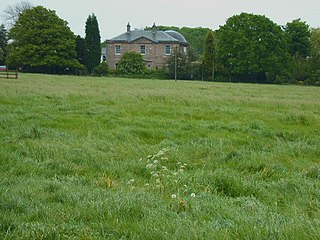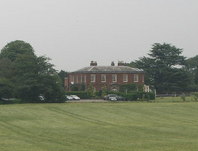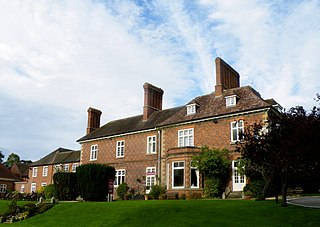Related Research Articles

Bretby Hall is a country house at Bretby, Derbyshire, England, north of Swadlincote and east of Burton upon Trent on the border with Staffordshire. It is a Grade II listed building. The name Bretby means "dwelling place of Britons".

Drayton Manor, one of Britain's lost houses, was a British stately home at Drayton Bassett, since its formation in the District of Lichfield, Staffordshire, England. In modern administrative areas, it was first put into Tamworth Poor Law Union and similar Rural Sanitary District, 1894 to 1934 saw its inclusion in Tamworth Rural District, and in the next forty years it lay in the 1974-abolished Lichfield Rural District.

Beaudesert was an estate and stately home on the southern edge of Cannock Chase in Staffordshire. It was one of the family seats of the Paget family, the Marquesses of Anglesey. The estate was obtained by William Paget, 1st Baron Paget in 1546; the family's other main seat is at Plas Newydd.

Little Aston Hall is a Georgian country house in Little Aston, Staffordshire, England.
Sedgley urban district was a local government district within Staffordshire, which was created in 1894 from the western half of the manor of Sedgley.

Dunstall Hall is a privately owned 18th century mansion house near Tatenhill, Burton upon Trent, Staffordshire. It is a Grade II* listed building.

Dunston is a small village in England lying on the west side of the A449 trunk road about 3 miles (4.8 km) south of Stafford, close to Junction 13 of the M6 motorway. The population of the village at the 2011 census was 281. It lies at roughly 300 feet above sea level.

Amington Hall is an early-19th-century former country house at Amington, near Tamworth, Staffordshire, which has been converted into residential apartments.

Peplow Hall is a privately-owned 11,635 square feet (1,080.9 m2), 18th-century mansion at Peplow, near Hodnet, Shropshire. It is a Grade II* listed building.

Barrells Hall is a large house in the Warwickshire countryside near Henley-in-Arden. The nearest village is Ullenhall, which for many years was the estate village, large parts of it having been built by the owners of Barrells Hall, the Newtons, one of the families who formerly owned Barrells. An adjacent house named Barrells Park was built in about 1950 on part of the Barrells estate.
Elmhurst Hall was a country house in the village of Elmhurst, Staffordshire. The house was located approximately 1.5 miles north of the city of Lichfield.

Moreton Hall is a Grade II* listed building in Bury St Edmunds, a market town in the county of Suffolk, England. It was designed by the Scottish architect Robert Adam and built in 1773 as a country house for John Symonds (1729–1807), a clergyman and Professor of Modern History at Cambridge University. The building was originally known as "St. Edmund's Hill". It was later called "The Mount" and from 1890 "Moreton Hall".
Teddesley Hall was a large Georgian English country house located close to Penkridge in Staffordshire, now demolished. It was the main seat firstly of the Littleton Baronets and then of the Barons Hatherton. The site today retains considerable traces of the hall, gardens and other buildings, while the former home farm remains a working farm.

Tittensor village is located in Staffordshire, England, between Newcastle-under-Lyme and Stone. The population as taken at the 2011 census can be found under Swynnerton. The village consists of mostly 1960s housing as well as the few remaining houses from the 19th century. Historically Tittensor forms part of Stone parish. The Tittensor family occupied a manor house which passed to the Gerrard family sometime before 1405. The house was destroyed and rebuilt several times over the centuries, and was finally demolished in 1834. Some of the materials were used to build St Luke's church in Tittensor which was constructed in 1880-81. The ruins of the manor house remained until they were finally demolished in the early 1960s.

Bradgate House is a 16th-century ruin in Bradgate Park, Leicestershire, England.

Greenham Hall is a country house at Wellington in Somerset. It was once the home of Admiral of the Fleet Sir John Kelly. It is a Grade II listed building.

Dovecliff Hall is a large Georgian country house in Stretton, East Staffordshire, England which is now a country house hotel. It is a Grade II listed building.

Albrighton Hall near Shrewsbury, Shropshire, is a house which is Grade II* listed on the National Heritage List for England. It was built in 1630 for the Ireland family and remained in this family for the next five generations until 1804. It was then the home of several notable people until 1953. In the 1990s it was converted into a hotel.

Greaves House, now known as Greaves Park, is a Grade II listed house in Lancaster, England, now a pub and restaurant, and is also the name of the surrounding public park. It was built in 1843 by the Reverend Samuel Simpson and was the residence of many notable people for the next century.

Yeldersley Hall is a building of historical significance in Ashbourne, Derbyshire, England and is listed on the English Heritage Register. It was built in about 1800 by a wealthy landowner and was the residence of many notable people over the next two centuries. Today it is a venue for special events, particularly weddings.